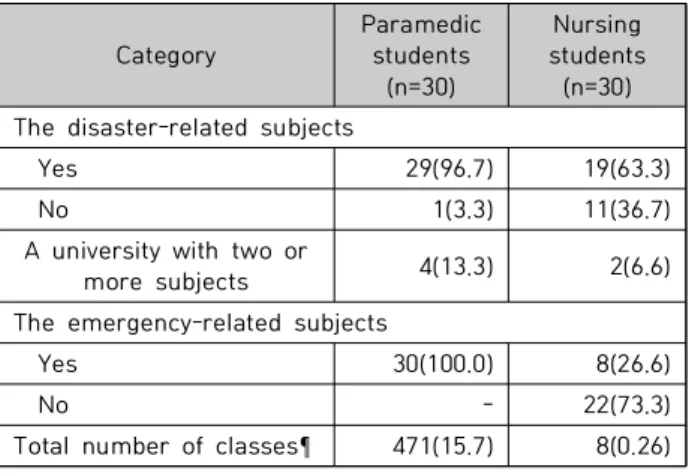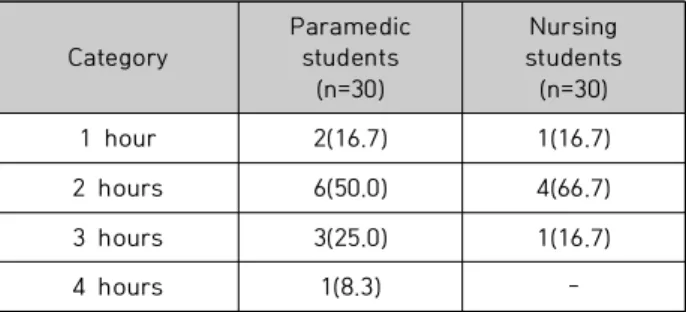JKSCI
A Comparative Analysis of Disaster-Related Curriculum between Emergency Department and Nursing Department
1)
Ji-Yeon Jung*
*Professor, Dept. of Emergency Medical Service, Howon University, Gunsan, Korea [Abstract]
This study is a descriptive research to compare and analyze the current status of disaster-related curriculum between emergency department and nursing department
Research and analysis targets were 41 universities which include the emergency department in South Korean by using the universities’ internet homepage, finally 30 universities were researched by removing the universities which doesn’t upload the curriculum on their homepage, have emergency department or have nursing department.
The research data were collected and analyzed by using the universities’ internet homepage.
The Keyword is ‘Disaster’, ‘Catastrophe’, and ‘Emergency’ to search the name of the subjects. The curriculum calculated as a percentage of frequency by using the status of disaster-related subjects opening, classification of major education, grade, credit, number of class, practical hours, and the total number of subjects.
According to the study, 29 universities (96.7%) of emergency department and 19 universities (63.3%) of nursing department has the disaster-related subjects in their curriculum. The current status of the class opening is emergency department at second grade and nursing department as fourth grade. As a subject of major, two credits are the common class credits. Based on the results of the study, knowledge and skills and training courses are necessary to develop the ability to cope with disasters in the disaster field. The curriculum that matches the role of health care resources will be required.
▸Key words: Disaster-Related Curriculum, Emergency Department, Nursing Department [요 약]
본 연구는 응급구조학과와 간호학과에서 실시되는 재난관련 교육과정의 현황을 비교 분석하기 위한 서술적 조사 연구이다. 연구 분석대상은 인터넷 홈페이지를 이용하여 전국의 응급구조학과 가 개설되어 있는 41개 대학을 대상으로 조사하였으며, 교육과정이 등재되어있지 않은 학교와 간 호학과가 없는 학교를 제외하고 나머지 30개 대학을 연구대상으로 하였다. 연구 자료는 인터넷 홈페이지를 이용하여 교육과정을 수집하여 분석하였다.
키워드 ‘재난’, ‘재해’,‘응급’을 이용하여 만든 교과목을 조사하였으며, 교육과정은 재난관련 교 과목의 개설현황 , 전공교양 분류, 학년, 학점, 이론 및 실습 시간 시수, 총 과목 개설수를 빈도와 백분율로 산출하였다.
연구결과는 재난관련 교과목 개설 현황은 응급구조학과는 29개교(96.7%) 간호학과 19개교(63.3%)였다.
개설 현황은 응급구조학과 2학년, 간호학과는 4학년이 가장 많았으며, 전공선택으로 2학점 개설이 가장 많았다. 본 연구결과를 토대로 재난에 대처할 수 있는 능력을 기르기 위해서는 재난현장에 맞는 지식과 술기가 필요하며 보건의료자원의 역할에 맞는 교육과정이 완성되어야 할 것이다 .
▸주제어: 재난관련 교육과정, 응급구조학과, 간호학과
∙First Author: Ji-Yeon Jung, Corresponding Author: Ji-Yeon Jung
*Ji-Yeon Jung (cjy504@hanmail.net), Dept. of Emergency Medical Service Howon University
∙Received: 2019. 09. 02, Revised: 2019. 09. 19, Accepted: 2019. 09. 23.
Copyright ⓒ 2019 The Korea Society of Computer and Information http://www.ksci.re.kr pISSN:1598-849X | eISSN:2383-9945

